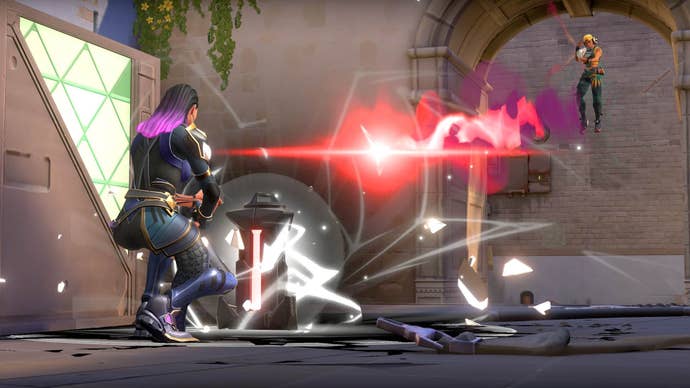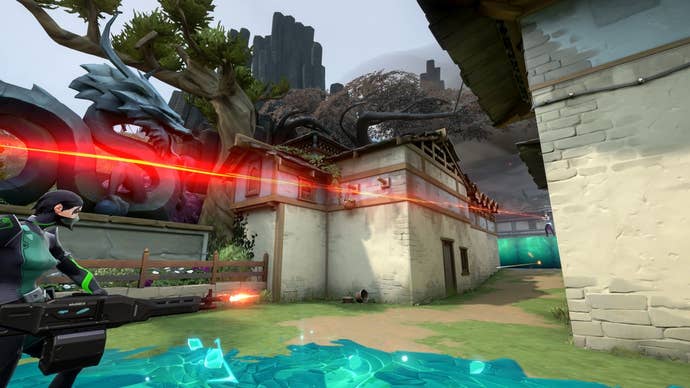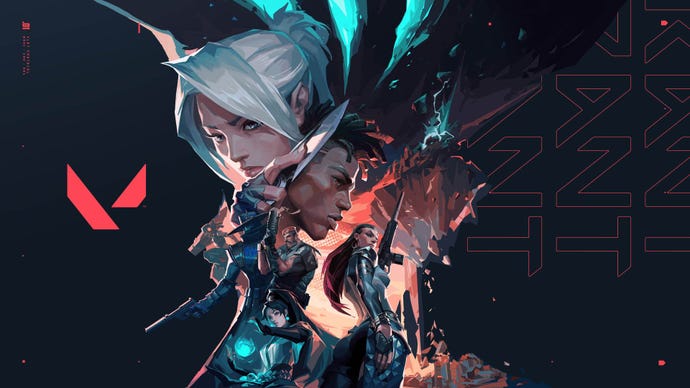Valorant Review: A Compelling Counter Strike
Riot Games' foray into FPS territory is solid, even if it's slim at the moment.
This article first appeared on USgamer, a partner publication of VG247. Some content, such as this article, has been migrated to VG247 for posterity after USgamer's closure - but it has not been edited or further vetted by the VG247 team.
Valorant enters the tactical shooter ring with an advantage. Specifically, it has a pretty deep well of experience to draw from, both from Riot Games's experience in building League of Legends into a worldwide esport, and its spiritual predecessor Counter-Strike's decades of evolution and iteration.
In that respect, Valorant doesn't try to hide its most prominent influences. The various Agents that populate the character select screen have abilities and ultimates, and they make quips throughout each match. Its focus on vision, information, and skill is made visually clear. The most expensive sniper rifle is called "The Operator," which has already been shortened to "The Op" in-game by players; phonetically identical to Counter-Strike's AWP.
It's how Valorant builds on these ideas, expanding on them and ingraining them into the moment-to-moment action, that has made it the most engaging take on this style of game I've played since the early, early days of Counter-Strike. It's still imperfect in places, but Valorant is off to a very strong start.
Don't Peek
The central mode of Valorant will feel functionally similar to anyone who's played Counter-Strike before, or even variants like Call of Duty's Search and Destroy. Opposing teams of five players square off, with one defending several important sites, and the other trying to plant and "detonate" a spike on one of those sites. A round is won by either eliminating the opposing force, or by completing the objective, with offense winning if the spike goes off, and defense winning if they defuse it.
The first team to 13 rounds won takes it, and offense and defense swap halfway through. Individual rounds can be fast, as they last minutes at the most, and are often times decided in the fury of a few moments. There's no regenerating health, only one healing-focused character, and bullets hit pretty hard. It's not uncommon to get punished for poking your head around a suspicious corner with a split-second shot to the head.

Valorant's guns all feel good to handle, which is pleasantly surprising. In most FPS games, a hierarchy of weapons can be quickly sussed out, as the outright best options and overall trends emerge. And to be clear, there are superior and inferior guns: a Vandal is going to do more damage than a Stinger, and a Sheriff is going to drop an enemy faster than the base pistol. But I rarely felt punished for leaning into my preferences, whether I wanted to opt for a shotgun over the standard submachine gun, or the silenced pistol in round one versus the common auto-pistol.
Running underneath all this is the economy, the mini-metagame of Valorant. Each player gets an allowance to spend at the start of a round to buy equipment, whether that means primary weapons, sidearms, protective shields, or utility abilities. Agents have a signature ability that's always available, two more stocked in the shop, plus an ultimate that charges up a pip for every round, kill, or orb retrieved from the battlefield. The abilities are powerful, but most cost time or cash, which is what drives the pace of play.
Income is buoyed by either getting kills and successful plants/defuses, or by simply surviving a round and retaining equipment to the next. Valorant isn't just a game about properly clicking pixels as they round corners, but managing the ebb and flow of advantages between teams. Common expressions like "let's buy this round" means the team should spend its cash, either to maintain a lead or turn the tides. Conversely, "saving" means buying as little as possible, often sandbagging the round in order to build up funds for a big buy down the line. Rounds are one thing, but winning a match in Valorant means stringing together a series.
Valorant inherits a lot of jargon and mechanical understanding built over years of development, and still benefits from that structure. But one of the best things it does is codify those elements and shave down some of the excess. Players can buy weapons for each other with surplus funds straight from the in-game buy menu, rather than having to toss weapons at each other in spawn (don't worry, you can still do that if you want). Item and ability descriptions present simple, clean breakdowns of damage and effects caused just by hovering them.
Valorant's map is particularly strong in this regard. In the corner of the screen sits a semi-transparent minimap, which can be expanded into a fullscreen map at any time. Every section of the map is labeled with callouts, which act as quick shorthand to shout during a firefight. Instead of trying to describe an area of the A site, you can say someone is peeping the A window. Valorant not only places these labels on the map, but highlights your current location under minimap and displays teammates' locations when they speak through in-game voice chat. There are still context-specific pieces of lingo to learn like "heaven," but all of this serves to smooth what might otherwise be a rough part of the learning process.

Clear sight lines, for both the player and their teammates, show up on the minimap, as does a radial circle of sound that emerges whenever you do something that can be heard by other players. This not only makes it easy to quickly grok the best places to stand and watch but it also connotes importance. Competitive games like Valorant can seem, to someone not insulated in FPS games, like another deathmatch game. Accuracy and reflexes are still important, but the value of information is paramount.
For Counter-Strike veterans, this sentiment is preaching to the choir; but to a horde of genre newcomers likely migrating over from League of Legends, the clarity it offers is a godsend. There are only a handful of maps in Valorant right now, but each one feels constructed to facilitate interesting engagements between players. Again, years of Counter-Strike map development have contributed to this effort, but that doesn't belittle the work done here. Battlefields like Bind and Split have become fast favorites of mine, and Haven's three-site structure adds an interesting twist for Counter-Strike pros to adjust to and dissect. Finding which route is best, and playing rope-a-dope with shifting strategies and fake-outs, is easy thanks to the simple and competition-focused map designs.
The information warfare culminates in Agent abilities, which—for the most part—focus on concepts like zone control, movement, and sight rather than just a point-and-click source of damage. To kill another player, you're going to have to be able to shoot. But setting up the ideal conditions for that shot? That's well within the realm of abilities, which replace the usual arsenal of frag grenades, smoke canisters, and molotov cocktails.
Each Agent falls under a general class descriptor that helps outline their kit's strengths: Duelists tend to be aggressive and combat-focused, eager for the one-on-one matchup, while Sentinels watch the flank and control rotations. Signature abilities tend to define an Agent, as these are available every round, regardless of how rich or broke you are. Sage's heal or Viper's screen are the bread-and-butter of every round, often used to take control of a site or deter a push into one.
More expensive abilities tend to be a little more game-changing or add further advantage to an Agent's kit. Combinations like Phoenix's curveball and wall can be devastating, but these both cost money to replenish, metering their usage early on. Ultimate abilities, meanwhile, can only be earned over the course of rounds, but their gradual accumulation offsets the fact that these are often an Agent's trump card.
It's hard to deny that abilities have an overt affect on the pace of the game. Purists can bemoan when an ability tilts a round in a team's favor, but I like the addition a lot. They're an effective way of breaking stalemates and reinforcing good habits, but the balance is still in flux. Agents can dip in and out of favor like any other game, though some—like Sage—seem more necessary to have every match than others.
Each Agent's added style helps keep Valorant lively, though it is absolutely, 100 percent, a first-person tactical shooter. There are guns that shoot bullets, and characters die. The addition of more colors, visible effects to signify certain Agents (it's easy to tell if an orb of smoke was placed by Brimstone or Viper, for instance), and the less grim and militarized look of Agents adds a little more flair and personality to each round. With each successive kill in a streak, strings ramp up the tension, and if it culminates in a team wipe and win, they surge into a chorus. (The sound design is also fantastic, by the way.) Valorant doesn't look like every other military shooter on the market, and that alone is a boon; but having recognizable characters, with clearly defined abilities and little quips and banter to pad out the quiet moments of a match, add just enough lore flavor to hook me in.
Reviews of multiplayer games can feel like a futile effort. They have a half-life, and it usually runs out pretty fast, as the game continues to evolve, address concerns, add features, and build up over time. In that regard, this is like a time capsule that I get to bury in text on a website, and maybe someday I'll get to revisit and see if it holds up or if, like with other games, my feelings have shifted or cooled.
Valorant's launch is a strong offering, but it is certainly just a foundation right now. Though the faster Spike Rush mode is a novel distraction, there's really only one main mode to Valorant. While the maps are good, there's not many of them either. The firing range's aim trainer and jumping puzzle add interesting distractions, but what's currently in the game can feel pretty slim at times, especially if you're needing a break from the competitive heat.

For now, the best praise I can give Valorant is that it compels me forward. With so many competitive games vying for attention every day, many offer the allure of what greater time investment will bring, promising a deep and rewarding game that will quench the competitive drive within. For many games, that falls short. But with Valorant, the more I play, the more I feel I'm growing and learning, becoming better at both playing the game and understanding it. It feels good to pop off with a triple kill or a punishing headshot in Valorant, like it would in most games. Even just improving at my role as a Valorant player, learning new ways to smoke a site for an offensive push, or better angles to launch a Sova arrow into enemy territory for crucial information, is rewarding. I'm enjoying Valorant where I'm at now, and just as importantly, I'm interested to see how I feel 100 hours from now.
ConclusionValorant leans heavily on its predecessors, but makes use of established schools of thought and the unique novelties of its Agents to create a fresh take on tactical shooters, even if its launch is a little slim. For years, there hasn't been a fight for Counter-Strike's throne; but in Valorant, Riot Games has found a valiant contender.





.jpg?width=291&height=164&fit=crop&quality=80&format=jpg&auto=webp)












